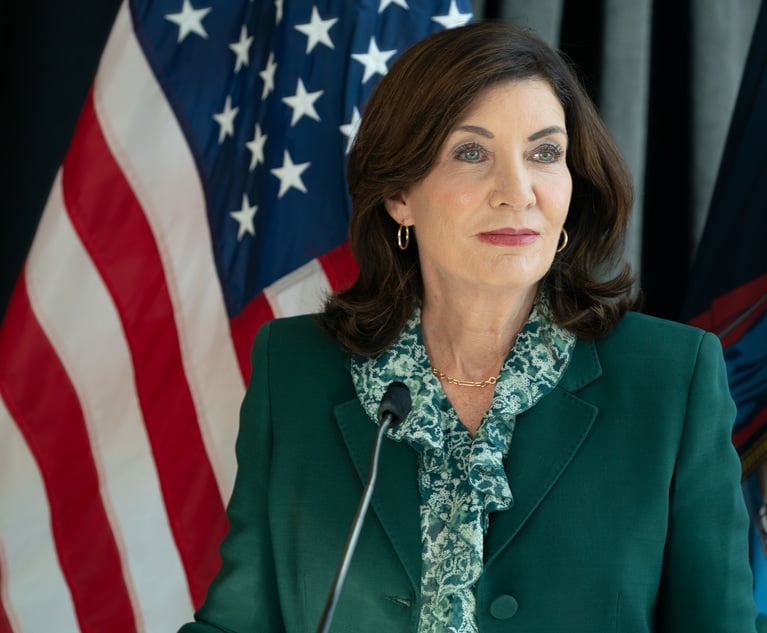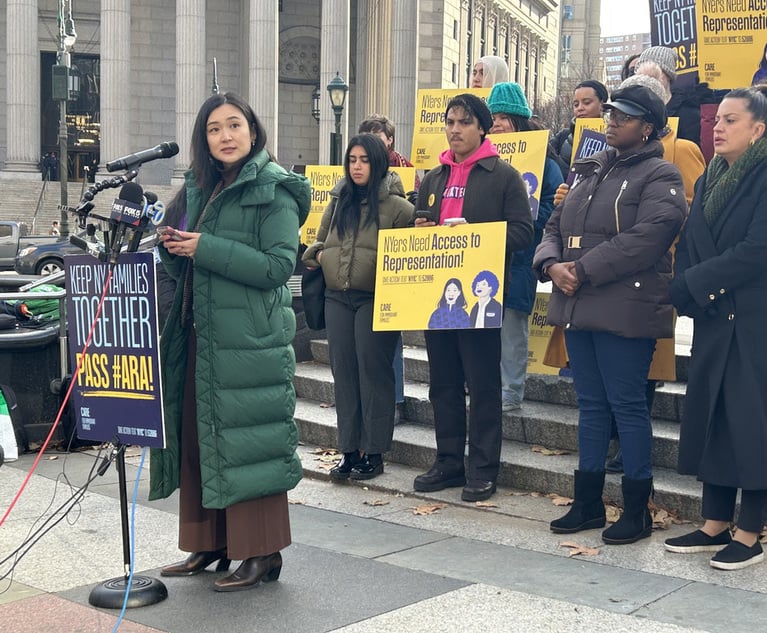 Gov. Andrew Cuomo. Photo: Peter Foley/Bloomberg
Gov. Andrew Cuomo. Photo: Peter Foley/Bloomberg1st Dept Reduction of Argument Days Spotlights Judge Shortage; Cuomo Urged to Act
The latest reduction to oral argument sessions would have a disproportionate impact of commercial cases and could create a troubling backlog for a court that prides itself on its ability to resolve complex appeals quickly and efficiently, sources said.
November 21, 2019 at 12:31 PM
7 minute read
Facing a number of long-standing judicial vacancies, the New York Supreme Court, Appellate Division, First Department announced earlier this week that it would be reducing its weekly oral argument sessions from three to just two.
The move, set to take effect at the start of the court's January 2020 term, came on the heels of a related decision by Presiding Justice Rolando Acosta in April to scale back appellate panels from five to four judges.
Both measures were seen by lawyers and former judges as the result of Gov. Andrew Cuomo's failure to appoint judges in a timely manner, even as the First Department continues to operate shorthanded. But the latest reduction to oral argument sessions would have a disproportionate impact of commercial cases and could create a troubling backlog for a court that prides itself on its ability to resolve complex appeals quickly and efficiently, sources said.
A spokesman for Cuomo said he had no comment on Office of Court Administration operations.
An OCA spokesman earlier in the week said the presiding justice "must balance the time that the court hears oral arguments with conference and chambers time for the associate justices."
"As the court returns to its full compliment of judges, Justice Acosta will modify the oral argument sessions as appropriate," he said in an emailed statement.
Many of the attorneys contacted for this report asked not to be identified by name, either for concern of possibly riling the governor or because of their proximity to the issue.
Acosta, who has headed the First Department since May 2017, was widely praised by those in the bar for managing the situation as best he could, given the resources at hand. Much of the frustration was directed instead at the governor's office, which drew sharp criticism for its seeming reluctance to prioritize judicial appointments.
The First Department, known for its hot docket and outsize volume of complex commercial appeals, is currently down five justices on its 20-member bench following a series of retirements that date back to 2017.
Cuomo earlier this month appointed Justice Lizbeth Gonzalez to fill a vacancy created by the elevation of Justice Paul Feinman to serve on the New York Court of Appeals in June 2017. However, three current vacancies remain unfilled following the retirements of Justice Karla Moskowitz at the end of 2017 and Justices Richard Andrias and Marcy Kahn in 2018 and 2019, respectively.
Two other judges, Justices John Sweeny and Peter Tom, have also announced their decisions to step down on Dec. 31, and are no longer hearing new cases. Justice Rosalyn Richter has said she will officially retire in June 2020, though she continues to take cases for the time being.
Amid the shortage, Acosta was forced earlier this year to break with tradition by reducing panels to just four judges, a necessary but unpopular move that affected the time judges are able to spend preparing cases and writing their opinions, lawyers said.
The decision also has the potential to cause a procedural logjam because when the panels split 2-2, a fifth judge must be brought in to break the tie, court watchers said. Practitioners facing four-judge panels can preserve the right to reargue in front of the fifth judge or the fifth judge can use the record to make a decision.
With the latest announcement, however, the consequences were seen as potentially even more dire.
The First Department typically hears between 23 and 25 cases at each of its three weekly sessions, where the court is obligated by law to prioritize Family Court cases and criminal appeals. In 2018, the court decided more appeals than had been perfected, but the loss of one of those weekly sessions could mean that there would be about 100 appeals each month that the court may not be able to consider.
Any resulting backlog, sources said, would particularly impact appeals out of the Supreme Court's Commercial Division, which has been competing with London, Delaware's Chancery Court and the Southern District of New York to attract filings. Businesses, especially, value prompt resolutions to disputes, and unnecessary delay could potentially reverse the inroads that New York had made with the corporate community.
"The Appellate Division, First Department receives the largest number of complex commercial litigations of any appellate court in the state," said retired Justice David Saxe, who is now a partner at Morrison Cohen.
"In order to maintain the Commercial Division's importance and prestige to the bar and the business community, it is necessary for the intermediate appellate court that hears the great bulk of its appeals to have adequate horsepower from experienced trial judges. To date, the governor's appointments have reflected this necessity."
Michael Miller, the immediate past president of the New York State Bar Association, said that the cutback in weekly sessions could also encourage litigants to forgo oral arguments altogether in order to more quickly obtain decisions, and he agreed that the new arrangement could ultimately damage New York's standing with businesses, if allowed to continue.
"Taken together, four-judge panels and a significant reduction in the number of weekly oral argument sessions are likely to erode the attractiveness of New York as a venue of choice and impair New York's standing for commercial disputes," Miller said.
"Contrasted with the considerable challenges of modernizing New York's antiquated and Byzantine court system, these are problems that are easily solved. The governor simply needs to make appointments to address the unfilled vacancies on the Appellate Division, First Department," he added.
Still, many in the bar have expressed anger at what is perceived as Cuomo's lack of attention to judicial vacancies, both in the First Department and elsewhere.
Despite Cuomo's Nov. 1 announcement appointing Gonzalez to the First Department and five other judges to openings on the Appellate Division's four other departments, bar members said they were puzzled by the amount of time it takes the governor to address vacancies.
In New York, screening committees in each of the judicial departments assess applicants and pass on a short list of qualified candidates to the governor. His final selections are not subject to a confirmation vote or other review by lawmakers.
Though the cause for the delays was not clear, there was wide agreement that Cuomo was not acting quickly enough to fill judicial vacancies.
Moskowitz said she had experienced other judge shortages during her time on the bench, but the current one was more severe and long-lasting than any that she had seen. Moskowitz, now a mediator with National Arbitration and Mediation, said that, until addressed, the impact of the vacancies on the court's overall caseload and its individual cases would be "enormous."
"I think that the problem will exist until there's more judges," she said. "The governor may be busy with other things, but the lawyers and litigants are suffering."
Read More:
This content has been archived. It is available through our partners, LexisNexis® and Bloomberg Law.
To view this content, please continue to their sites.
Not a Lexis Subscriber?
Subscribe Now
Not a Bloomberg Law Subscriber?
Subscribe Now
NOT FOR REPRINT
© 2025 ALM Global, LLC, All Rights Reserved. Request academic re-use from www.copyright.com. All other uses, submit a request to [email protected]. For more information visit Asset & Logo Licensing.
You Might Like
View All
So Who Won? Congestion Pricing Ruling Leaves Both Sides Claiming Victory, Attorneys Seeking Clarification
4 minute read
Hochul Vetoes 'Grieving Families' Bill, Faulting a Lack of Changes to Suit Her Concerns

Court System Names New Administrative Judges for New York City Courts in Leadership Shakeup
3 minute read
Law Firms Mentioned
Trending Stories
- 1Eversheds Sutherland Adds Hunton Andrews Energy Lawyer With Cross-Border Experience
- 2Balancing Judicial Authority: Understanding Sanctions, Severance, and Interferences
- 3Up in the Air: Boeing’s Deferred Prosecution Saga Continues
- 4Legal Tech's Predictions for Knowledge Management in 2025
- 5Fenwick Shutters Shanghai Office
Who Got The Work
Michael G. Bongiorno, Andrew Scott Dulberg and Elizabeth E. Driscoll from Wilmer Cutler Pickering Hale and Dorr have stepped in to represent Symbotic Inc., an A.I.-enabled technology platform that focuses on increasing supply chain efficiency, and other defendants in a pending shareholder derivative lawsuit. The case, filed Oct. 2 in Massachusetts District Court by the Brown Law Firm on behalf of Stephen Austen, accuses certain officers and directors of misleading investors in regard to Symbotic's potential for margin growth by failing to disclose that the company was not equipped to timely deploy its systems or manage expenses through project delays. The case, assigned to U.S. District Judge Nathaniel M. Gorton, is 1:24-cv-12522, Austen v. Cohen et al.
Who Got The Work
Edmund Polubinski and Marie Killmond of Davis Polk & Wardwell have entered appearances for data platform software development company MongoDB and other defendants in a pending shareholder derivative lawsuit. The action, filed Oct. 7 in New York Southern District Court by the Brown Law Firm, accuses the company's directors and/or officers of falsely expressing confidence in the company’s restructuring of its sales incentive plan and downplaying the severity of decreases in its upfront commitments. The case is 1:24-cv-07594, Roy v. Ittycheria et al.
Who Got The Work
Amy O. Bruchs and Kurt F. Ellison of Michael Best & Friedrich have entered appearances for Epic Systems Corp. in a pending employment discrimination lawsuit. The suit was filed Sept. 7 in Wisconsin Western District Court by Levine Eisberner LLC and Siri & Glimstad on behalf of a project manager who claims that he was wrongfully terminated after applying for a religious exemption to the defendant's COVID-19 vaccine mandate. The case, assigned to U.S. Magistrate Judge Anita Marie Boor, is 3:24-cv-00630, Secker, Nathan v. Epic Systems Corporation.
Who Got The Work
David X. Sullivan, Thomas J. Finn and Gregory A. Hall from McCarter & English have entered appearances for Sunrun Installation Services in a pending civil rights lawsuit. The complaint was filed Sept. 4 in Connecticut District Court by attorney Robert M. Berke on behalf of former employee George Edward Steins, who was arrested and charged with employing an unregistered home improvement salesperson. The complaint alleges that had Sunrun informed the Connecticut Department of Consumer Protection that the plaintiff's employment had ended in 2017 and that he no longer held Sunrun's home improvement contractor license, he would not have been hit with charges, which were dismissed in May 2024. The case, assigned to U.S. District Judge Jeffrey A. Meyer, is 3:24-cv-01423, Steins v. Sunrun, Inc. et al.
Who Got The Work
Greenberg Traurig shareholder Joshua L. Raskin has entered an appearance for boohoo.com UK Ltd. in a pending patent infringement lawsuit. The suit, filed Sept. 3 in Texas Eastern District Court by Rozier Hardt McDonough on behalf of Alto Dynamics, asserts five patents related to an online shopping platform. The case, assigned to U.S. District Judge Rodney Gilstrap, is 2:24-cv-00719, Alto Dynamics, LLC v. boohoo.com UK Limited.
Featured Firms
Law Offices of Gary Martin Hays & Associates, P.C.
(470) 294-1674
Law Offices of Mark E. Salomone
(857) 444-6468
Smith & Hassler
(713) 739-1250






